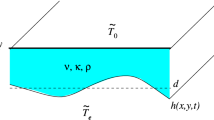Summary
The Stokes-Taylor instability of a thin fluid layer is studied by the usual first order perturbation method. The density of the layer is assumed to be constant or to vary exponentially through it. It is bounded on either side by media of constant density. Particular attention is paid to determining the exponential rates of growth of perturbations at the two interfaces, and the effect of the layer in reducing the instability of the interface between the bounding media formed in the absence of the layer. When the layer is of variable density and the acceleration acts in the direction of increasing density, there is an infinity of modes of internal instability which do not affect the interfaces. There are also two modes of interfacial instability which are similar to those occurring when the layer is of constant density.
Similar content being viewed by others
References
Hide, R., Proc. Camb. Phil. Soc. 51 (1955) 179.
Stokes, G. G., Trans, Camb. Phil. Soc. 8 (1847) 441.
Taylor, G. I., Proc. Roy. Soc. A 201 (1950) 192.
Rayleigh, Proc. Lond. Math. Soc. 14 (1883) 170.
Lin, C. C., The Theory of Hydrodynamic Stability, Camb. Univ. Press, Cambridge 1955.
Lamb, H., Hydrodynamics, Camb. Univ. Press, Cambridge 1932.
Author information
Authors and Affiliations
Rights and permissions
About this article
Cite this article
Hunt, J.N. Taylor instability in a thin fluid layer. Appl. sci. Res. 10, 45 (1961). https://doi.org/10.1007/BF00411897
Received:
DOI: https://doi.org/10.1007/BF00411897



